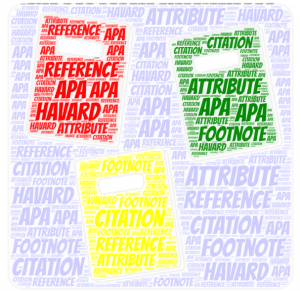Integrity at University
Rowena McGregor and Robyn Tweedale

INTRODUCTION
Integrity underpins every aspect of working with information at university. It starts with finding the best resources to address your topic, continues with taking accurate notes and using appropriate writing and presentation techniques, and finishes with accurate, honest, and clear communication regarding where and when you used information resources, and who contributed to your work. You will probably encounter the term “academic integrity” frequently while you are a student. Understanding and applying academic integrity is essential for success at university. This chapter will begin by explaining the essence of academic integrity. It will then focus on referencing as referencing is a key skill that demonstrates academic integrity. This will be followed by a discussion of threats to your academic integrity and actions you can take to support and demonstrate integrity.
“Academic integrity means acting with the values of honesty, trust, fairness, respect and responsibility in learning, teaching and research” (Exemplary Academic Integrity Project, 2013).
WHAT IS ACADEMIC INTEGRITY?
Academic integrity is honest, respectful, and ethical behaviour within the university environment. Examples include being honest by indicating where and how often you use information created by others. You must be respectful of the work of others and communicate their ideas correctly. You must be ethical and not claim the work of others as your own, or present work that is merely a list of what others have said on the topic without critical or intellectual work of your own. Helpful behaviours that show integrity include using the referencing style supported by your university, ensuring all the work you submit is your own, and abiding by copyright laws when using and sharing information (TEQSA, n.d.).
Referencing

Referencing is the consistent and structured attribution of all ideas, words, images, statistics, and other information to the source. In other words, referencing allows you to clearly and accurately communicate where you found the information you used in your assignments. There are thousands of referencing styles, most falling within the author-date or numbered referencing families. Check your university website for guidance on the style to use and how to reference in that style. Following is a description of the author-date and numbered referencing style families.
Author-date referencing styles
Author-date referencing styles require the name of the author (or authors) and the year of publication to be provided as an in-text citation whenever you use someone’s words, ideas, images or other work. This means that several sentences within a paragraph may contain one or more in-text citations. The author’s name and date may be written as part of the sentence, for example: Bonner (2017) argued that Parliament was hostile to Indigenous politicians. In-text citations can also be provided in brackets at the end of the sentence, for example: The Parliament was hostile to Indigenous politicians (Bonner, 2017).
Author-date styles also include a reference list, usually on a separate page at the end of the essay, presentation, report or literature review. The reference list contains everything mentioned as an in-text citation – and nothing else. This means you cannot include sources in your reference list other than those you have cited within the text. Each entry in the reference list provides the name of the author(s) or creator(s), the date of publication, the title of the work and where it was produced or available online. The American Psychological Association (APA) and Harvard styles are commonly used examples of author-date referencing styles.
Numbered referencing styles
Numbered referencing styles require a number in each sentence where someone’s words, ideas, images or other works have been used. The details of the work – names, dates, title and location – are provided in footnotes, or a numbered list at the bottom of every page. Endnotes, or the entire list of references provided at the end of your work are preferred in some numbered referencing styles. The Australian Guide to Legal Citation (AGLC) and Vancouver are two examples of numbered referencing styles.
This was a brief introduction to referencing styles. Please speak to your lecturer or university librarian to determine the specific referencing style you should use, and for guidance on how to use that style in your assessment.
Bibliographic software
Your university may make bibliographic software such as EndNote, Mendeley, RefWorks, Paperly or others available to students to download to their personal computers and devices. Such software can assist you with managing your information sources and referencing. If you would like to use a bibliographic software program, please note that it takes time to learn to use the software effectively. Be aware that until you are fluent in your referencing style, you will not be able to recognise and correct any referencing errors these programs can generate when used incorrectly. Developing your skills by manually creating your references will prepare you to use bibliographic software. Please speak to a librarian for guidance on when it is appropriate to use bibliographic software.
THREATS TO ACADEMIC INTEGRITY

Using correct referencing will help demonstrate academic integrity, but it is not the only behaviour to consider. There are some behaviours that you should avoid. Threats to your academic integrity include plagiarism, contract and other forms of cheating, collusion and fabricating information (TEQSA, 2019, p. 3). Avoiding these behaviours is essential if you want to show honest, respectful and ethical conduct. Avoiding these behaviours will allow you to avoid penalties for academic misconduct. Penalties differ between universities but can include having to rewrite a piece of assessment, failing a course or, in extreme cases, being excluded from your study program and the university. Following is a list of threats to academic integrity and strategies to avoid these threats.
Plagiarism
Plagiarism is the accidental or deliberate use of other people’s work without sufficient attribution. In effect, you are claiming someone else’s work as your own. Accidental plagiarism can be avoided by using effective notetaking practices (see the chapter Notetaking). Notetaking will ensure you have details needed to accurately report and attribute the resources you use. Paraphrasing – or rewriting the original ideas in your own words – is also required. Paraphrasing allows you to focus on aspects of an original work that support your arguments and to synthesise from multiple sources of information (APA, 2019). See the chapter Writing Assignments for more on paraphrasing.
Self-plagiarism
Self-plagiarism is re-use of your own work in a subsequent assignment. At first glance this may appear to be an efficient use of your time and effort. However, self-plagiarism does not demonstrate that you have learned anything new. Likewise, self-plagiarism does not show that you have achieved the expected outcomes of your course. You can use the same sources of information, but to avoid self-plagiarism you will need to write a new assignment to address the new topic, question or perspective.
Collusion
Collusion occurs when a student works with others – students, friends, paid tutors, family members – and then submits that shared work as if it is their own original work (Crook & Nixon, 2018). Collusion may be evident when:
- many students in a course submit assignments sharing similar content, references and structure
- the quality of work submitted by a student varies more than what may be expected due to conditions such as ‘exam nerves’
- work is submitted with very few citations

Working with others and discussing the content of a course or the requirements of an assignment can be productive and enjoyable. However, you may like to avoid sharing your drafts without a clear expectation of what you want to achieve from the sharing. For example, you may like to ask for feedback on the clarity of your work and specify that any reader must not change your draft. You may also decide to only share your drafts with the academic and professional staff employed by your university to help people with their academic skills: learning advisors, learning support and academic advisors, for example.
Contract cheating
Contract cheating occurs when a student pays someone else to complete their assessment – to sit their exam, or to write their essay. Clearly this activity undermines the value of your qualification. If students cheat their way to graduation, and then cannot perform the skills or demonstrate the attributes required by their employers and colleagues, the qualification will soon be judged to be worthless. Another problem with contract cheating is that you may become vulnerable to being blackmailed by the same criminals who provided the essay. These criminals have been known to contact the students they helped to cheat and threaten to expose them to the university or to their employer unless they make additional payments (Lancaster, 2016).
If you find yourself considering cheating due to time pressure, there are other options you can consider that demonstrate academic integrity. You may ask if an extension is available, or consider if a small penalty applied for late submission is acceptable. Communicate with your lecturer as early as possible to discuss your options. The chapter Time Management will be helpful for planning into the future.
Fabricating data
Whether you perform an experiment in a lab, collect data from another setting, or find data in a scholarly or other source, it is important to report this data clearly and accurately. Do not fabricate data to show a fake finding or outcome. In the case of unexpected lab results, this may provide an interesting opportunity to discuss the limitations of an experiment or how unanticipated conditions may have skewed the results. The discussion section of an assignment can benefit from the skilful handling of something that may have first appeared to be a disaster. In the case of not finding sufficient data from a scholarly source, the chapter Working with Information will help you to find relevant data.
There are many risks to academic integrity, but all of these risks can be mitigated by being mindful when working with information and when working with others. Beyond being vigilant, it is a good idea to access the resources your university will provide to help you maintain your academic integrity.
SUPPORTING YOUR ACADEMIC INTEGRITY
Your university will provide resources to help you with your academic integrity. These resources will include referencing guides and support for academic writing that will encompass key skills such as paraphrasing and note taking. Support may be available in the form of online guides, workshops, or in-person academic or learning advisory services. You may also have the opportunity to use a licensed text matching software program.
Text matching software

Your university may subscribe to text matching (sometimes called ‘plagiarism detection’) software. Turnitin and iThenticate are examples of software that match text to detect – and help students avoid – plagiarism. These tools search the internet and university assessment repositories to find any text in your assignment that matches to other sources, including websites, scholarly literature, grey literature, and other student assignments. If you have the opportunity to submit a draft assignment to such software before you submit your final assignment, please do so. Use of this software will generate a report and alert you to any text matches. This will allow you to use your referencing and paraphrasing skills to correctly attribute all the ideas in your work and avoid plagiarism. You may need to check with your university contact person for help interpreting the report.
CONCLUSION
Academic integrity governs all that you do at university. Academic integrity is made visible by the accurate attribution of ideas, images or other information you use in your work according to the rules of your university’s preferred referencing style. It is also important to only submit your own original work for assessment, or to clarify the contributions of others where relevant. When reading your work, your lecturer should be able to identify the ideas you used to support your thinking and be confident that anything else is your personal contribution. Being diligent with referencing, and with only submitting work that is your own, are two clear ways to act with academic integrity.
Key points
- Academic integrity underpins everything you do at university.
- Academic integrity requires the honest, respectful and ethical use of information.
- Cite and reference all your information sources as described by your university referencing guides.
- Provide a citation every time you use someone’s ideas, words, diagrams, audio or other information.
- When sharing work with peers, provide clear instructions regarding the feedback you are seeking.
- Cheating in any form undermines the value of your degree and leaves you vulnerable to academic penalties and blackmail.
References
American Psychological Association. (2019). Paraphrasing. https://apastyle.apa.org/style-grammar-guidelines/citations/paraphrasing
Crook, C., & Nixon, E. (2019). The social anatomy of ‘collusion’. British Educational Research Journal, 45(2), 388-406. https://doi.org/10.1002/berj.3504
Exemplary Academic Integrity Project (EAIP): Embedding and extending exemplary academic integrity policy and support frameworks across the higher education sector (2013). Plain English definition of academic integrity. Office for Learning and Teaching Strategic Commissioned Project 2012-2013. http:www.unisa.edu.au/EAIP
Lancaster, T. (October 20, 2016). ‘It’s not a victimless crime’ – the murky business of buying academic essays. The Guardian. https://www.theguardian.com/higher-education-network/2016/oct/19/its-not-a-victimless-the-murky-business-of-buying-academic-essays
Tertiary Education Quality and Standards Agency (TEQSA). (2019). Guidance note: Academic integrity. https://www.teqsa.gov.au/latest-news/publications/guidance-note-academic-integrity
Tertiary Education Quality and Standards Agency (TEQSA). (n.d.). What is academic integrity? https://www.teqsa.gov.au/what-academic-integrity
ACKNOWLEDGEMENTS
We would like to acknowledge our colleague Susanne Schultz for her valuable feedback on this chapter.

